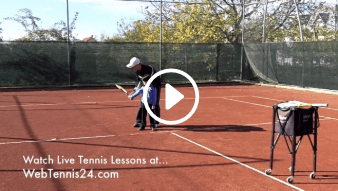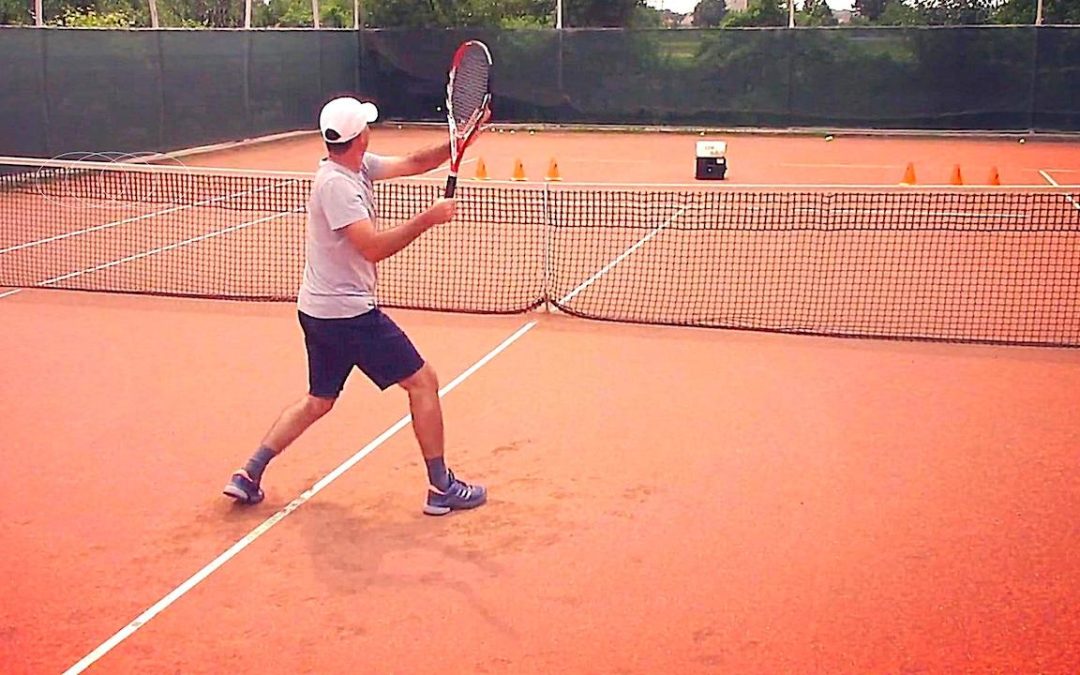


Tennis Tactics and Strategies for Singles Play
To enjoy competing in tennis, there are some basic aspects that every player should strive to accomplish. They are:
1. Consistency – It is the player’s ability to hit the ball over the net and land it inside the court as many times as necessary.
I would say, for a beginning level, the player should be able to hit at least 5 balls in a row over the net and inside the court, during a pressure situation.
As you develop a better technique, footwork and feel, consistency could mean hitting 10 or more balls in, under pressure. I consider a match-play situation to be a pressure situation. You must know that it is a lot easier to be consistent with your strokes when there is no fear of missing (like in practice) than when every point counts towards winning or losing a match.
Consistency is directly related to other skills like footwork, balance, timing, coordination, preparation, ball control, technique and mental control. As you can see, tennis is a sport that relies on multiple skills and qualities that must all work together at a certain moment.
If you look at the statistics, you will notice that most matches are lost and not won. By that, I mean tennis is a game of consistency – the player who makes the fewest errors will win most of the time. Winning shots (winners) account for only 5 – 10% of all the points won. So it basically comes down to winning by missing less.
2. Placement
Being able to place the ball wherever you wish on the opposite side of the net is the second most important tactic in tennis.
That means you can hit cross-court, down-the-line, down-the-center, short, deep etc.
Suppose that you discover your opponent has a weak backhand. Being able to direct your shots to that area will make winning the match a lot easier.
3. Spin
Putting spin on the ball increases your ability to control and place the ball. Spin will also slow down a fast ball due to the air pressure exercised upon it.
We can distinguish four basic types of spin:
– flat (very little rotation of the ball) – flat serve, overheads, volleys etc.
– top spin (low to high brushing motion on the back of the ball) – groundstrokes, swing volleys, serve etc.
– under spin (high to low brushing motion on the back of the ball) – volleys, slice groundstrokes, drop shots etc.
– side spin (right to left or left to right brushing motion on the back of the ball) – slice serves, some of the groundstrokes etc.
4. Power
It’s the ability of a player to produce high ball velocity on a shot.
Power should be used only after the previous elements (consistency, placement and spin) have been acquired. Power without control (consistency) is nothing.
All the previous tactics can be very successful without power but power without them is useless. A ball hit with velocity must have the required amount of spin in order to come down into the court.
Power and spin must be used together.
5. Move the opponent
It is a lot easier for everybody to control a ball when they don’t have to move too far, or too fast to get to it. Therefore to make your opponent struggle to return the ball, hit it away from him. That affects his timing, body balance and as a result, racquet and ball control.
6. Strength vs. Weakness
Using your strengths to exploit your opponent’s weaknesses is another tactic that should not be neglected. Your strength can be either physical (better, more powerful strokes, foot speed, stamina etc.) or mental (good knowledge of tactics and strategies, better concentration, mental toughness, perseverance etc.).
7. Variety
It is very difficult for your opponents to control their timing, body balance and rhythm when the balls you send come in different ways: low, high, short, deep, with slice or topspin… Vary your types of shots to get the opposition out of their comfort zone.
You can also surprise the other player by varying the tactics you apply. For example, add a serve and volley to your normal baseline game. Your opponent should be uncertain of what you will come up with next. If not, he will enjoy playing you if there is predictability in your game.
Tactics for Beginning Players
Tactics for Intermediate Players
Tactics for Advanced Players
How to Play against Defensive Baseliner
How to Play against Offensive Baseliner
How to Play against All-Court Player
How to Play against Serve-and-Volley
How to Play against Left-Handed Player
How to Play against Inside-Outer
How to Pass the Net Opponent
How to Return a Drop-Shot
Singles Court Coverage – Lesson 1
Singles Court Coverage – Lesson 2
Singles Court Coverage – Lesson 3
Singles Court Coverage – Lesson 4
Get instant access to the above-mentioned singles tactics and strategy lessons inside the Ultimate Training for Tennis Players program!
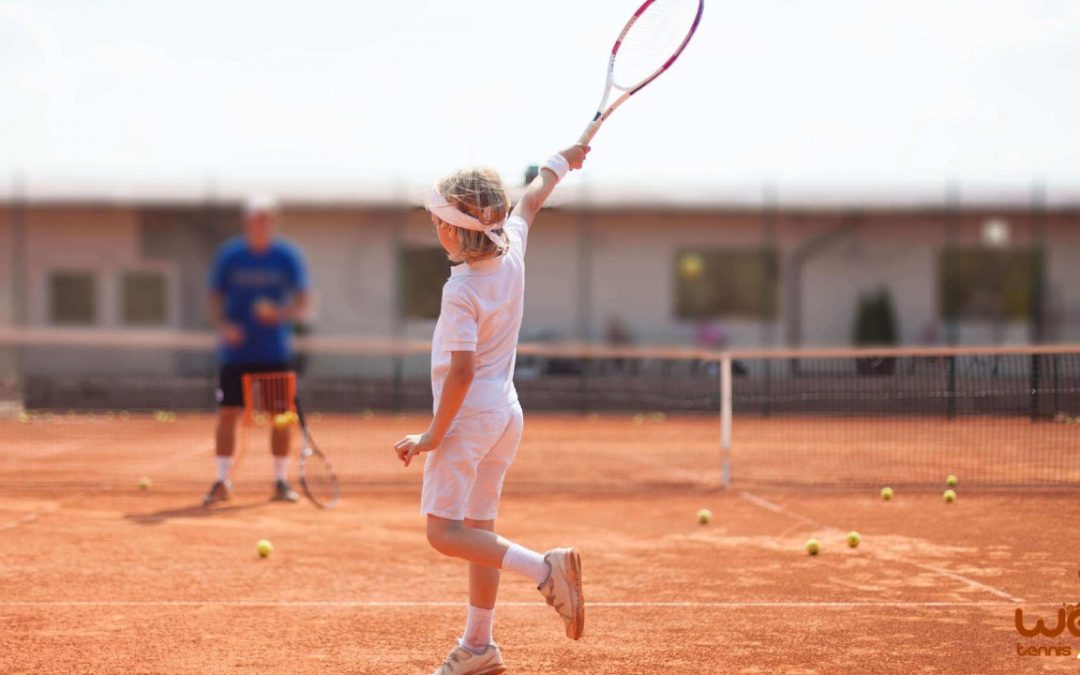
Basket Tennis Drills for Coaches
In this section, you will discover basket tennis drills for private and group lessons.
Tennis basket drills are a training method where a coach or partner feeds balls from a basket, allowing for close observation and correction of a player’s footwork, technique, and strategic shot selection.
Big Square (private or group)
The coach (F) stands just behind the service line with a basket of balls ready; he will hand-feed (toss) balls from the basket. The student begins the drill from behind the baseline, on the same side as the coach.
Drill Pattern: The coach will feed the balls as follows:
– 1 short for the player to come up and execute a forehand cross-court;
– 1 deep so that the player backs up and hits another forehand, directed down the line;
– 1 short so that the player comes up for a backhand cross-court;
– 1 deep for the player to back up and execute another backhand groundstroke down the line.
The drill continues in this pattern three more times. Emphasis is made on proper preparation, footwork (sprint and stop), and balance control.
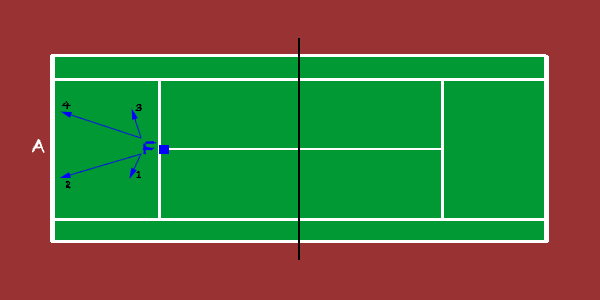
Serve and Put Away (private or group)
The drill begins with the first player in line ready to serve from the deuce side. The coach is on the opposite side, ready for the incoming serve; he has a basket nearby, ready to feed from.
Drill:
The player will serve (1) and then move up while the coach feeds a ball short (2) into her court. She will attack the short ball for a down-the-line put-away shot (3).
After that, the player will move to the end of the line, not before getting a ball from the coach’s basket and making way for the next player.
Once every player does the drill at least 6 times, the servers and coach can switch sides: the players serving from the ad side.

Waiting for the Overhead (private)
The coach (F) is about halfway between the service line and the baseline; he has a basket of balls to feed from. The player (A) is on the other side of the net, at the service line.
Drill:
The coach will begin the drill by feeding balls randomly for the player to volley. The player will have to execute 5 successful volleys in (anywhere inside the court) for her to receive a lob.
If, at any time, she misses in her attempt to get 5 volleys in, the coach will continue feeding but he will re-set the counting to 0.
Only once she hits 5 consecutive volleys in and the overhead she can move back to the service line and have a 10-second break if needed.
Do the drill at least 5 times.
Note: This is a very good drill for volley consistency, maintaining focus, and… good workout.

For many more basket tennis drills, check out the coaching programs at WebTennis24, and the Tennis Drills and Lesson Plans for Coaches!
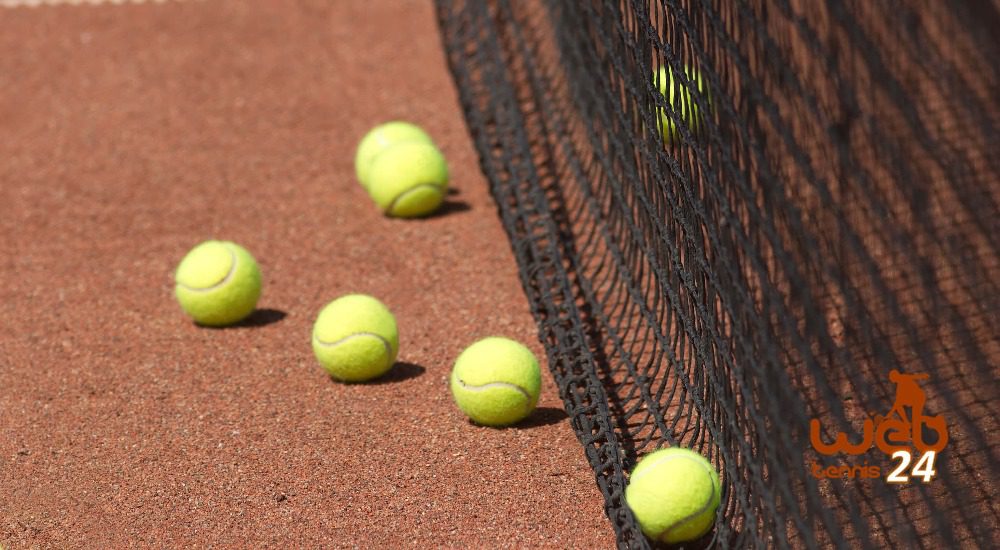
Tennis Drills for Large Groups
In this section, you will discover tennis drills for coaching large groups of players.
Practice strokes technique, footwork, accuracy, and consistency.
You’ll also find drills for players to improve their singles and doubles skills specific to their needs and level of play.
First Cone Down
The players are divided into two teams, and line up behind the baseline (one line on the ad, one on the deuce side), ready to serve.
Each team has 3 cones next to them; the basket of balls is placed just behind the baseline center, between the two teams (see graphic below).
Drill:
Players, in each team, take turns one at a time, serving one ball.
For every serve in, the respective team scores 1 point.
As soon as one of the teams scores 10 points, the last player to serve the ball in will take the 3 cones and place them randomly inside the service box the team was aiming for.
From that point on, as soon as a player hits any one of the 3 targets, their team wins the game; at this time, the other team will try to catch up and place their cones as well inside the service box and knock a cone before their opponents.
Once the game is over, the teams switch sides and play again.
Note:
This is a fun competitive serving game that can be played by beginning, as well as advanced players.

Fear No Volleys
This is a 3-ball drill that can be played with large groups of players.
There is a team A-B at the baseline; on the opposite side baseline, the rest of the players line up in teams: C-D ready to play and the rest waiting their turn.
The coach (F) is on the same side as team C-D, ready to feed from the basket – see the graphic below.
Drill:
1. The coach will feed a short ball for team A-B to move up toward the net; at the same time, team C-D approaches the net too. They play the point out while the coach reminds all players to move up and take all the balls in the air.
2. For the second point all teams are now at the net; the coach feeds a volley to team A-B. They play the point out.
3. For the third point, the coach will send a lob for team A-B; C and D move back quickly to defend against the overhead.
The team that wins at least 2 out of the 3 points stays and plays against the next team in line: if team A-B wins, they move back to the baseline; if team C-D wins they replace team A-B.
Notes:
– If the number of players waiting in line is an odd one, the first two players form a team.
– This drill is recommended for intermediate and advanced players.

King of the Court – Doubles
Two players (A, B) on one side in a one-up/one-back formation (they are the kings/queens of the court). On the other side, two other players in a one-up/one-back formation also (challengers). The rest of the players line up behind the baseline waiting for their turn, on the challengers’ side.
The coach is on the side of the challengers, feeding balls from the basket to the kings of the court to start the point.
Teams play best of 3 points.
– If the kings win, their team stays put; the challengers will then rotate one spot counter-clockwise and the new team will challenge the kings.
– If the kings lose, they will move to the end of the line on the challengers’ side. The team that beat them will take their spot as the new kings. Two more challengers will step up to play the new kings.

Access many more coaching drills for large groups inside the Tennis Drills and Lesson Plans for Coaches program!
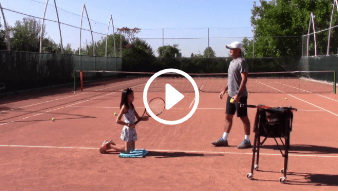
MY DADDY / MY COACH – Live Tennis Lessons (page 3)
MY DADDY / MY COACHTennis Parents: How to Teach Your Kids to Play Tennis- Section 3 of 3 – In this section, you’ll see how Cosmin Miholca, a certified tennis coach, teaches his two daughters tennis. It starts with their first lesson where they learn the...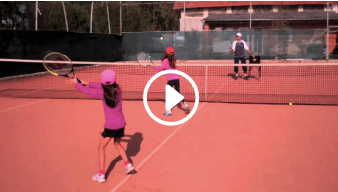
MY DADDY / MY COACH – Tennis Parents: How to Teach Your Kids to Play Tennis (2 of 3)
MY DADDY / MY COACHTennis Parents: How to Teach Your Kids to Play Tennis- Section 2 of 3 – In this section, you’ll see how Cosmin Miholca, a certified tennis coach, teaches his two daughters tennis. It starts with their first lesson where they learn the...